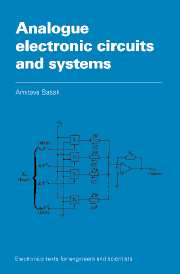5 - Phase-locked loops
Published online by Cambridge University Press: 05 June 2012
Summary
Objectives
At the end of the study of this chapter a student should be:
familiar with three basic functional blocks of a phase-locked loop
familiar with the principle of operation of a phase-locked loop as a whole
able to determine important PLL parameters such as lock range and acquisition range
familiar with typical applications, both in electro-mechanical and telecommunication systems.
The phase-locked loop (PLL) is a very useful and versatile building block in the frequency domain. It is available from manufacturers as a single integrated circuit. It helps to synchronise the output signal of an oscillator with a reference signal in both frequency and phase. While synchronised in frequency, the phase difference between the output signal and the input signal is zero, or very small. It works in much the same way as a general feedback loop which acts in most control systems, e.g., electronic, mechanical, as shown in Fig. 5.1. Here the input is a function of the desired output. If the output is different from the desired value, the mixer produces an error signal which is then amplified and corrects the output. Although its concept has been known since 1932, its application was restricted until the 1960s, when it first became available in an integrated circuit form.
Components of phase-locked loops
The PLL contains a phase detector, a low-pass filter and a voltage-controlled oscillator in an arrangement as shown in Fig. 5.2.
- Type
- Chapter
- Information
- Analogue Electronic Circuits and Systems , pp. 169 - 191Publisher: Cambridge University PressPrint publication year: 1991



